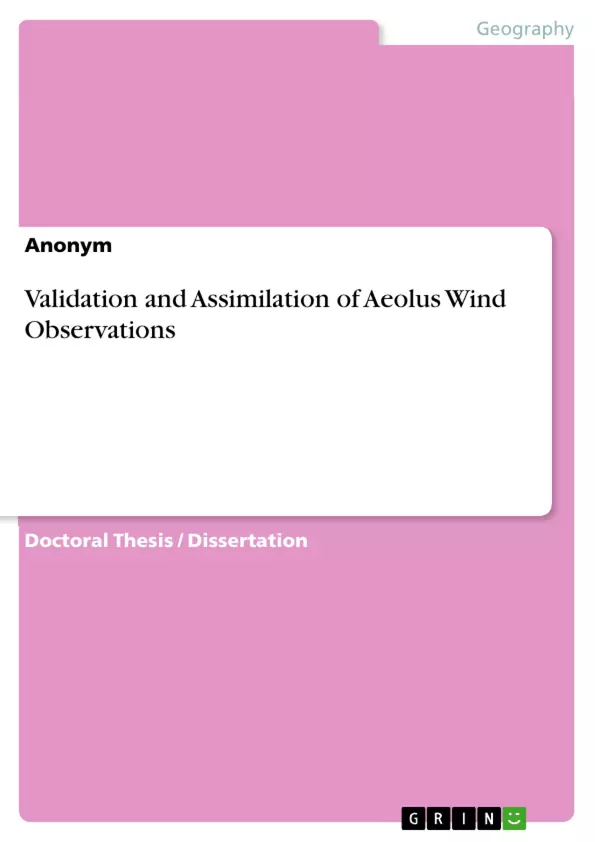Along with scientific and technological developments, the advancement of the Global Observing System (GOS) has been one of the most important factors contributing to the increase in numerical weather forecasting (NWP) skill in recent years. The initial conditions of a forecast are provided by data assimilation systems, combining the latest short-range forecast with a selection of atmospheric observations. One of the current major limitations is the lack of global wind profile observations, particularly in regions and for spatial scales where geostrophic mass-wind coupling is weak. The European Space Agency’s (ESA) Doppler Wind Lidar (DWL) satellite mission Aeolus provides a novel data set of wind profiles with quasi-global coverage intended to fill these data gaps in the current GOS. Therefore, it is of great interest to assess the impact of the Aeolus observations in NWP to demonstrate the potential value of such satellite-based DWL missions.
A crucial prerequisite for using meteorological observations in NWP data assimilation systems is a comprehensive knowledge of their errors. The first part of this thesis investigates the Aeolus data quality through comparisons with three independent reference data sets: collocated radiosonde observations and model equivalents of the global ICOsahedral Nonhydrostatic (ICON) model of Deutscher Wetterdienst (DWD) and the Integrated Forecast System (IFS) model of the European Centre for Medium-Range Weather Forecast (ECMWF).
This enables a comprehensive estimation and characterization of the systematic and random errors of the Aeolus wind profile observations. Approaches to correct for the analyzed complex systematic errors that can be used in the context of quality control in data assimilation systems are being tested. Furthermore, to obtain a meaningful estimation of the Aeolus instrumental error, the representativeness errors for the comparisons are determined based on high-resolution regional model simulations. The results show the importance of accounting for representativeness errors for the mission’s calibration and validation activities and provide an estimate of the vertical structure of the Aeolus Rayleigh and Mie wind instrumental error that can be used for the assigned observation error in data assimilation.
The second part of this thesis examines how numerical weather forecasting benefits from the assimilation of the novel DWL observations from the Aeolus satellite.
Inhaltsverzeichnis (Table of Contents)
- Chapter 1: Introduction
- 1.1 State of the art
- 1.1.1 Importance of atmospheric wind observations for NWP
- 1.1.2 Deficiencies in the global observing system
- 1.1.3 Wind profile observations from space - historical scientific and technological background
- 1.1.4 Aeolus mission objectives
- 1.2 Research goals and outline of the thesis
- Chapter 2: Basic principles
- 2.1 Aeolus observations
- 2.1.1 DWL ALADIN measurement concept
- 2.1.2 Level-2B wind processing
- 2.1.3 Overview: Satellite orbit and measurement geometry
- 2.1.4 Main changes in the Aeolus L2B data set during the mission
- 2.2 Data assimilation
- 2.2.1 Three-dimensional variational assimilation
- 2.2.2 Ensemble Kalman Filter
- 2.2.3 Global data assimilation system at DWD
- 2.2.4 Observation error components in data assimilation
- Chapter 3: Data and methodology
- 3.1 Data sets and methods for the Aeolus HLOS wind validation study
- 3.1.1 Evaluation period and region
- 3.1.2 Collocated radiosonde observations
- 3.1.3 DWD ICON and ECMWF IFS model equivalents
- 3.1.4 Quality control criteria for the Aeolus HLOS wind observations
- 3.1.5 Representativeness errors
- 3.1.6 Statistical metrics
- 3.2 Data sets and methods to assess the impact of Aeolus HLOS wind assimilation
- 3.2.1 Experimental set up
- 3.2.2 Verification data and methods
- Chapter 4: Results: Validation of Aeolus HLOS wind observations
- Chapter 5: Results: Impact of Aeolus HLOS wind assimilation in the global model ICON
Zielsetzung und Themenschwerpunkte (Objectives and Key Themes)
This thesis aims to contribute to the optimal use of Aeolus wind observations in Numerical Weather Prediction (NWP) models and evaluate their benefits using the ICON model's global data assimilation system at the Deutscher Wetterdienst (DWD). The research addresses the characteristics of Aeolus wind observation errors, methods for error correction, the relative benefit of Aeolus observations within the DWD assimilation system, and dynamical scenarios linked to Aeolus's high impact on NWP forecasts.
- Validation of Aeolus HLOS wind profile observations.
- Assessment of systematic and random errors in Aeolus wind observations.
- Evaluation of bias correction methods for Aeolus data.
- Analysis of Aeolus observation impact on the ICON global assimilation system.
- Identification of dynamical scenarios driving Aeolus's impact on NWP forecasts.
Zusammenfassung der Kapitel (Chapter Summaries)
Chapter 1: Introduction Provides background on the importance of wind observations for NWP, highlighting deficiencies in the global observing system and the Aeolus mission's objectives. It outlines the research goals and the structure of the thesis.
Chapter 2: Basic principles Explains the fundamentals of Aeolus observations, including the ALADIN instrument and data processing. It also details relevant data assimilation methods, focusing on 3D-Var and EnKF/LETKF, and describes the DWD global data assimilation system.
Chapter 3: Data and methodology Describes the datasets used for the Aeolus HLOS wind validation study (radiosondes, ICON, and IFS model equivalents) and the impact study (OSE). It details the quality control procedures, representativeness error estimation, and statistical metrics employed.
Chapter 4: Results: Validation of Aeolus HLOS wind observations Presents the validation results, characterizing the systematic and random errors of Aeolus HLOS wind observations and investigating bias dependencies. It explores bias correction approaches.
Schlüsselwörter (Keywords)
Aeolus, Doppler Wind Lidar (DWL), Numerical Weather Prediction (NWP), data assimilation, 3D-Var, Ensemble Kalman Filter (EnKF), observation error, representativeness error, bias correction, Observing System Experiment (OSE), ICON model, ECMWF IFS model, Quasi-Biennial Oscillation (QBO), El Niño-Southern Oscillation (ENSO), extratropical transition (ET).
- Citation du texte
- Anonym (Auteur), 2023, Validation and Assimilation of Aeolus Wind Observations, Munich, GRIN Verlag, https://www.grin.com/document/1391403



